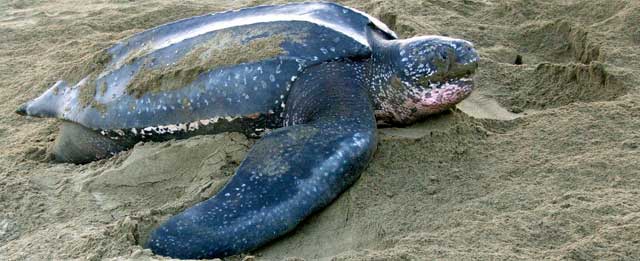(Dermochelys coriacea)
The largest of all living turtles, these ancient mariners have been swimming the world’s oceans for over 100 million years! Unlike other species of sea turtles, Leatherbacks do not have a bony shell. They get their name from the dark rubbery flexible shell which is marked by seven ridges and allows them to withstand the pressure of diving up to 4,000 feet below the surface of the sea. They can weigh up to 2000lbs and 10feet in length, but more commonly average 5-7 feet and 1000 lbs. They are found in all the world’s oceans.
Leatherback turtles are the most numerous sea turtle species nesting in Trinidad in Tobago. This important nesting population is the third largest in the world. Leatherbacks come from as far as Africa, Canada and the UK to nest on our beaches. The most important nesting sites in Trinidad are Matura Bay, Fishing Pond, and Grande Riviere and Turtle Beach in Tobago.
They are also particularly susceptible to ocean pollution, mistaking plastic bags for their favourite food, jellyfish. In Trinidad and Tobago, Leatherbacks are also still seen as a traditional, seasonal delicacy. The presence of SOS’s regular beach patrol, together with ongoing education and awareness campaigns has dramatically reduced the incidence of poaching that was once evident at Turtle Beach. However many rural beaches still go unmonitored and poaching during the nesting season remains a huge threat to the species locally.





